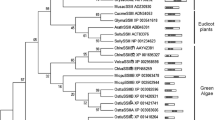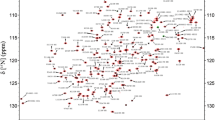Abstract
Starch synthase I (SSI) from various sources has been shown to preferentially elongate branch chains of degree of polymerisation (DP) from 6–7 to produce chains of DP 8–12. In the recently determined crystal structure of barley starch synthase I (HvSSI) a so-called surface binding site (SBS) was seen, which was found by mutational analysis to be essential for the activity of HvSSI on glycogen. We now show in binding studies using surface plasmon resonance that HvSSI has no detectable affinity for malto-triose and -tetraose, but clearly binds maltopentaose, -hexaose, -heptaose (M7) and β-cyclodextrin (β-CD) albeit with a measurable K D for only β-CD and M7. Moreover, an HvSSI SBS mutant F538A lost the ability to bind β-CD and maltooligosaccharides. This behaviour suggests that a chain in the α-glucan molecule (amylopectin) that is undergoing extension attaches itself at the SBS and that the active site itself, likely working on a different end chain, has low affinity for both substrate and product.
Similar content being viewed by others
Abbreviations
- ADPGlc:
-
ADP-glucose
- β-CD:
-
β-cyclodextrin
- CAZy:
-
Carbohydrate Active enZyme database
- DP:
-
degree of polymerisation
- GBSS:
-
granule-bound starch synthase
- HvSSI:
-
barley starch synthase I
- M3:
-
maltotriose
- M4:
-
maltotetraose
- M5:
-
maltopentaose
- M6:
-
maltohexaose
- M7:
-
maltoheptaose
- MOS:
-
maltooligosaccharides
- RU:
-
resonance unit
- PaGS:
-
Pyrococcus abyssi glycogen synthase
- SBS:
-
surface binding site
- SSI:
-
starch synthase I
- SSII:
-
starch synthase II
- SSIII:
-
starch synthase III
- SSIV:
-
starch synthase IV
References
Baskaran S., Chikwana V.M., Contreras C.J., Davis K.D., Wilson W.A., Depaoli-Roach A.A., Roach P.J. & Hurley T.D. 2011. Multiple glycogen binding sites in eukaryotic glycogen synthase are required for high catalytic efficiency toward glycogen. J. Biol. Chem. 286: 33999–34006.
Bozonnet S., Jensen M.T., Nielsen M.M., Aghajari N., Jensen M.H., Kramhøft B., Willemoës M., Trainer S., Haser R. & Svensson B. 2007. The’ pair of sugar tongs’ on the noncatalytic domain C of barley α-amylase participates in substrate binding and activity. FEBS J. 274: 5055–5067.
Cantarel B.L., Coutinho P.M., Rancurel C., Bernard T., Lombard V. & Henrissat B. 2009. The Carbohydrate-Active EnZymes database (CAZy): an expert resource for glycogenomics. Nucleic Acids Res. 37: D233–D238.
Cockburn D. & Svensson B. 2013. Surface binding sites in carbohydrate active enzymes: an emerging picture of structural and functional diversity, pp. 204–221. In: Rauter, P. & Lindhorst, T. (eds), Carbohydrate Chemistry vol. 39, Royal Society of Chemistry, Cambridge, United Kingdom.
Commuri P.D. & Keeling P.L. 2001. Chain-length specificities of maize starch synthase I enzyme: studies of glucan affinity and catalytic properties. Plant J. 25: 475–486.
Crumpton-Taylor M., Pike M., Lu K.J., Hylton C.M., Feil R., Eicke S., Lunn J.E., Zeeman S.C. & Smith A.M. 2013. Starch synthase 4 is essential for coordination of starch granule formation with chloroplast division during Arabidopsis leaf expansion. New Phytol. 200: 1064–1075.
Cuesta-Seijo J.A., Nielsen M.M., Marri L., Tanaka H., Beeren S.R. & Palcic M.M. 2013. Structure of starch synthase I from barley: insight into regulatory mechanisms of starch synthase activity. Acta Crystallogr. D Biol. Crystallogr. 69: 1013–1025.
Cuyvers S., Dornez E., Delcour J.A. & Courtin C.M. 2011. Occurrence and functional significance of secondary carbohydrate binding sites in glycoside hydrolases. Crit. Rev. Biotechnol. 31: 93–107.
Díaz A., Martínez-Pons C., Fita I., Ferrer J.C. & Guinovart J.J. 2011. Processivity and subcellular localization of glycogen synthase depend on a non-catalytic high affinity glycogenbinding site. J. Biol. Chem. 286: 18505–18514.
Fujita N., Yoshida M., Asakura N., Ohdan T. & Miyao A. 2006. Function and characterization of starch synthase I using mutants in rice. Plant Physiol. 140: 1070–1084.
Fujita N., Yoshida M., Kondo T., Saito K., Utsumi Y., Tokunaga T., Nishi A., Satoh H., Park J.H., Jane J.L., Miyao A., Hirochika H. & Nakamura Y. 2007. Characterization of SSIIIa-deficient mutants of rice: the function of SSIIIa and pleiotropic effects by SSIIIa deficiency in the rice endosperm. Plant Physiol. 144: 2009–2023.
Hanashiro I., Abe J. & Hizukuri S. 1996. A periodic distribution of the chain length of amylopectin as revealed by high-performance anion-exchange chromatography. Carbohydr. Res. 283: 151–159.
Jeon J.S., Ryoo N., Hahn T.R., Walia H. & Nakamura Y. 2010. Starch biosynthesis in cereal endosperm. Plant Physiol. Biochem. 48: 383–392.
Nielsen M.M., Bozonnet S., Seo E.S., Mótyán J.A., Andersen J.M., Dilokpimol A., Abou Hachem M., Gyémánt G., Naested H., Kandra L., Sigurskjold B.W. & Svensson B. 2009. Two secondary carbohydrate binding sites on the surface of barley α-amylase 1 have distinct functions and display synergy in hydrolysis of starch granules. Biochemistry 48: 7686–7697.
Pérez S. & Bertoft E. 2010. The molecular structures of starch components and their contribution to the architecture of starch granules: a comprehensive review. Starch 62: 389–420.
Przylas I., Terada Y., Fujii K., Takaha T., Saenger W. & Sträter N. 2000. X-ray structure of acarbose bound to amylomaltase from Thermus aquaticus. Implications for the synthesis of large cyclic glucans. Eur. J. Biochem. 267: 6903–6913.
Robert X., Haser R., Mori H., Svensson B. & Aghajari N. 2005. Oligosaccharide binding to barley α-amylase 1. J. Biol. Chem. 280: 32968–32978.
Roldán I., Wattebled F., Mercedes Lucas M., Delvallé D., Planchot V., Jiménez S., Pérez R., Ball S., D’Hulst C. & Mérida A. 2007. The phenotype of soluble starch synthase IV defective mutants of Arabidopsis thaliana suggests a novel function of elongation enzymes in the control of starch granule formation. Plant J. 49: 492–504.
Rolland-Sabaté A., Sanchez T., Buléon A., Colonna P., Ceballos H., Zhao S.-S., Zhang P. & Dufour D. 2013. Molecular and supra-molecular structure of waxy starches developed from cassava (Manihot esculenta Crantz). Carbohydr. Polym. 92: 1451–1462.
Sevcík J., Hostinová E., Solovicová A., Gasperík J., Dauter Z. & Wilson K.S. 2006. Structure of the complex of a yeast glucoamylase with acarbose reveals the presence of a raw starch binding site on the catalytic domain. FEBS J. 273: 2161–2171.
Szydlowski N., Ragel P., Raynaud S., Mercedes Lucas M., Roldán I., Montero M., Munoz J., Ovecka M., Bahaji A., Planchot V., Pozueta-Romero J., D’Hulst C. & Mérida Á. 2009. Starch granule initiation in Arabidopsis requires the presence of either class IV or class III starch synthases. Plant Cell 21: 2443–2457.
Umemoto T., Yano M., Satoh H., Shomura A. & Nakamura Y. 2002. Mapping of a gene responsible for the difference in amylopectin structure between japonica-type and indica-type rice varieties. Theor. Appl. Genet. 104: 1–8.
Zeeman S.C., Kossmann J. & Smith A.M. 2010. Starch: its metabolism, evolution, and biotechnological modification in plants. Annu. Rev. Plant Biol. 61: 209–234.
Zhang X., Colleoni C., Ratushna V., Sirghie-Colleoni M., James M.G. & Myers A.M. 2004. Molecular characterization demonstrates that the Zea mays gene sugary2 codes for the starch synthase isoform SSIIa. Plant Mol. Biol. 54: 865–879.
Zhu F., Bertoft E., Källman A., Myers A.M. & Seetharaman K. 2013. Molecular structure of starches from maize mutants deficient in starch synthase III. J. Agric. Food Chem. 61: 9899–9907.
Author information
Authors and Affiliations
Corresponding author
Rights and permissions
About this article
Cite this article
Wilkens, C., Cuesta-Seijo, J.A., Palcic, M. et al. Selectivity of the surface binding site (SBS) on barley starch synthase I. Biologia 69, 1118–1121 (2014). https://doi.org/10.2478/s11756-014-0418-0
Received:
Accepted:
Published:
Issue Date:
DOI: https://doi.org/10.2478/s11756-014-0418-0




